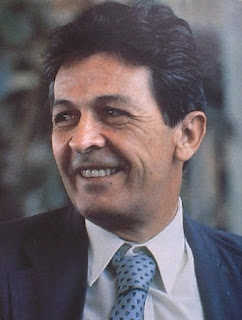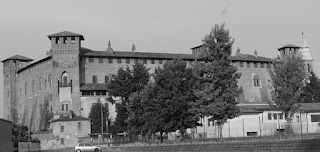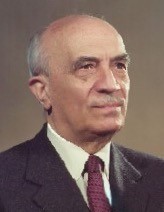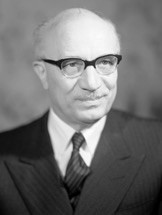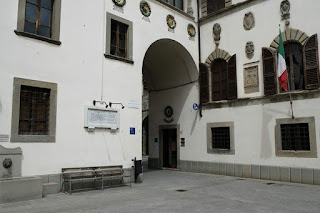Tough interior minister worked for social and economic reform
 |
| The Christian Democrat Mario Scelba became Italy's 33rd Prime Minister in February 1954 |
He earned the nickname ‘the Iron Sicilian’ while serving as Interior Minister because of his repression of both left-wing protests and Neo-Fascist rallies.
Scelba had been born into a poor family that worked on land owned by the priest Don Luigi Sturzo, who was to become one of the founders of the Italian People’s Party (PPI).
As his godfather, Sturzo paid for Scelba to study law in Rome. When the Fascists suppressed the PPI and forced Sturzo into exile, Scelba remained in Rome as his agent.
He wrote for the underground newspaper, Il Popolo, during the Second World War. He was once arrested by the Germans but freed after three days as he was considered to be ‘a worthless catch’.
After Rome’s liberation by the Allied Forces, Scelba joined the new Christian Democrats, reborn out of the PPI.
 |
| Scelba (right) served in two governments under Prime Minister Alcide De Gasperi (left) |
Scelba was Minister of Post and Telecommunications in Ferruccio Parri’s anti-Fascist government and in the two successive Governments of Alcide de Gasperi.
In 1947 as Interior Minister in De Gasperi’s third government, he became infamous for his hard line against the Communists and labour unions. He expelled former partisans from the police and cracked down on left-wing demonstrations, often using violence.
He thought the police were so ineffective at that time he once said if he were a Communist he would start a revolution the next day.
An Italian statute defining and banning fascism is known as the Scelba Law, but he wrote it to restrain the activities of the Communists as well.
Scelba increased police numbers and armed and equipped them with cars and jeeps to deal with riots. He made enemies because of his harsh methods and his concern for law and order but he also favoured social reforms and public works and attacked speculators for pushing up prices.
 |
| The bandit Salvatore Giuliano was blamed for the Portella della Ginestra massacre |
Scelba was involved in setting up the Gladio network, the clandestine NATO stay behind operation in Italy after the Second World War to organise resistance against an invasion of Europe.
In 1947, a few days after a victory for the left in local elections in Sicily, a Labour Day parade in Portella della Ginestra was attacked, culminating in the killing of 11 people and the wounding of more than 30.
The attack was attributed to the bandit leader, Salvatore Giuliano, and was thought to be punishment for the local election results.
Scelba reported to Parliament the next day that the police believed the massacre to be non-political.
But the Communist deputy, Girolamo Li Causi, claimed the Mafia had ordered the attack, working with landowners and monarchists.
In the summer of 1950 the men responsible for the attack went on trial in Viterbo. Scelba was accused of involvement in the plot to carry out the massacre but at the end of the trial the judge concluded that no higher authority had ordered the massacre and that Guiliano had acted autonomously.
 |
| Communist deputy Girolamo Li Causi claimed the massacre was ordered by the Mafia |
As Prime Minister of Italy between 1954 and 1955, Scelba tried to steer a middle course between the left and the right.
He worked for strong relations with the US and resolved outstanding wartime issues, such as the recovery of Trieste for Italy. In 1954 his Government passed a law introducing an investment plan for the public construction of economic housing.
Scelba was one of the last influential Christian Democrats to oppose the inclusion of left-wing Socialists in Government coalitions. In 1962 he was eventually dropped from Amintore Fanfani’s cabinet for that reason.
He was elected a senator in 1968 and served until his resignation in 1979. He was president of the European parliament from 1969 to 1971.
Scelba died of thrombosis at his home in Rome in October 1991, aged 90.
 |
| The city of Caltagirone in Sicily, where Prime Minister Mario Scelba was born in 1901 |
Caltagirone, where Mario Scelba was born, is a municipality about 70 km (43 miles) southwest of Catania in Sicily. In 1987 Caltagirone was given the title of city. It is well-known for the production of pottery, maiolica and terracotta wares. Its main attraction for visitors is the 142-step Scalinata di Santa Maria del Monte, which dates back to 1608. Each step is decorated with different hand painted ceramics using ancient designs. Every year on 25 July, the Feast Day of Caltagirone’s patron saint, St James, the staircase is illuminated with candles in different colours, arranged to look like a large work of art.
 |
| The jagged upright stones that mark the bleak site of the Porta della Ginestra Massacre |
The site of the Porta della Ginestra Massacre, which is about 4km (2.5 miles) southwest of Piana degli Albanesi and about 30 km (19 miles) from Palermo, is marked with 11 jagged upright stones, one for each of the victims, on the spot where they fell. May Day celebrations have been held there every year since 1893.
More reading:
The Porta della Ginestra Massacre
How novelist Leonardo Sciascia exposed the links between Italian politics and the Mafia
Francesco Cossiga's bid to keep the Communists out of power
Also on this day:
1533: The birth of philosopher Giacomo Zabarella
1568: The birth of Tommaso Campanella
1970: The birth of Paralympian Francesca Porcellato
Home


